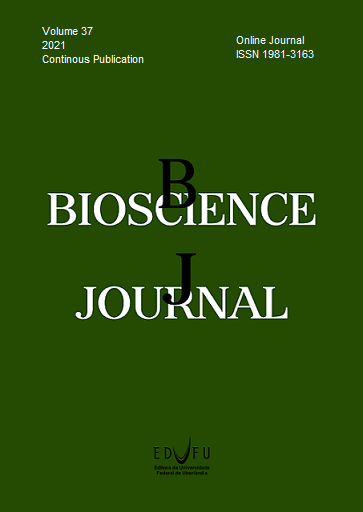Molecular biology as a diagnostic tool for detection of Leptospira spp. in cows of a border region – case report
DOI:
https://doi.org/10.14393/BJ-v37n0a2021-49895Keywords:
Acre, Bovinae, Herd, Leptospirosis, PCR, Reproduction, Vaginal Mucus.Abstract
The reproductive efficiency of livestock is the basis for the success of livestock, dairy or beef, and having high reproductive performance depends on several factors within the production system and the presence of infectious diseases of the reproductive sphere in the herd is one of the factors that can compromise that efficiency. The aim of this study was to use molecular biology as a diagnostic tool for the detection of Leptospira spp. DNA in cows with reproductive disorders on a rural property in the municipality of Boca do Acre, Amazonas, Brazil. Vaginal mucus was collected from nine Nelore breeding cows with a history of abortion and birth of weak calves submitted to DNA extraction and nested-PCR technique for 16S gene amplification at the bacterial genus level. Of the nine samples analyzed, five (55.55%) amplified a product of 331bp. The municipality of Boca do Acre is bordered by Peru and Bolivia, and knowledge of the prevalence of the disease, serovars, and circulating Leptospira species is essential for the adoption of measures related to animal husbandry, as well as health education for ranchers and their workers to avoid a possible occupational infection since this disease is considered an important zoonosis. New molecular studies using primers that allow the identification of the Leptospira species and mainly pathogenic species should be conducted in this region in order to elucidate the possible species of this etiological agent and the possible reservoirs of the disease to begin the understanding of the epidemiology of this disease in cattle in this region of border.
References
ALFIERI, A.A., et al. Frequency of group A rotavirus in diarrhoeic calves in Brazilian cattle herds, 1998–2002. Tropical Animal Health and Production. 2006, 38(7-8), p. 521- 526. https://doi.org/10.1007/s11250-006-4349-9
ANZAI, E.K. Utilização da PCR para o diagnóstico da leptospirose em cães naturalmente infectados por Leptospira spp. 2006. 48f. Dissertação (Mestrado) - Programa de Pós-Graduação em Ciência Animal, Universidade Estadual de Londrina, Londrina, Paraná, 2006.
BAL, A.E., et al. Detection of leptospires in urine by PCR for early diagnosis of leptospirosis. Journal of Clinical Microbiology.1994, 32(8), 1894-1898. https://doi.org/10.1128/jcm.32.8.1894-1898.1994
BARRAGAN, V., NIETO, N., KEIM, P. and PEARSON, T. Meta-analysis to estimate the load of Leptospira excreted in urine: beyond rats as important sources of transmission in low-income rural communities. BMC research notes. 2017, 10(1), 71-78. https://doi.org/10.1186/s13104-017-2384-4
CERVANTES, L.P.M., et al. Estudio serológico de leptospirosis bovina en México. Revista Cubana de Medicina Tropical. 2002, 54(1), 24-27.
DIRECTOR, A., et al. Isolation of Leptospira interrogans Hardjoprajitno from vaginal fluid of a clinically healthy ewe suggests potential for venereal transmission. Journal of medical microbiology. 2014, 63(9) 1234-1236. https://doi.org/10.1099/jmm.0.065466-0
EMBRAPA. Leptospirose. 1999 Available from: http://www.agencia.cnptia.embrapa.br/Agencia8/AG01/arvore/AG01_145_21720039244.html.
FAINE, S., ADLER, B., BOLIN, C., and PEROLAT, P. Leptospira and Leptospirosis. 2nd ed. Australia: MediSci, 1999.
FERREIRA, A.S., et al. Direct detection and differentiation of pathogenic Leptospira species using a multi-gene targeted real time PCR approach. PLoS One. 2014, 9(11), e112312. https://doi.org/10.1371/journal.pone.0112312
GROOMS, D.L., 2015. Infectious Agents: Leptospirosis. In: HOPPER, R.M. (ed.). Bovine Reproduction. Starkville: John Wiley & Sons, pp. 529-532.
HAMOND, C., et al. Urinary PCR as an increasingly useful tool for an accurate diagnosis of leptospirosis in livestock. Veterinary Research Communications. 2014, 38(1), 81-85. https://doi.org/10.1007/s11259-013-9582-x
IBGE. Bôca do Acre. 2018. Available from: https://pt.db-city.com/Brasil--Amazonas--B%C3%B4ca-do-Acre. Access at: 29 aug. 2020.
LILENBAUM, W., et al. Detection of Leptospira spp. in semen and vaginal fluids of goats and sheep by polymerase chain reaction. Theriogenology. 2008, 69(7), 837-842. https://doi.org/10.1016/j.theriogenology.2007.10.027
MÉRIEN, F., et al. Polymerase chain reaction for detection of Leptospira spp. in clinical samples. Journal of clinical microbiology. 1992, 30(9), 2219-2224. https://doi.org/10.1128/jcm.30.9.2219-2224.1992
NALLY, J.E., et al. Comparison of Real-Time PCR, Bacteriologic Culture and Fluorescent Antibody Test for the Detection of Leptospira borgpetersenii in Urine of Naturally Infected Cattle. Veterinary Sciences. 2020, 7(2), 66, 2020. https://doi.org/10.3390/vetsci7020066
OIE. Manual de diagnóstico, testes e vacinas de animais terrestres. 2008.
OLIVEIRA, F.S., et al. Avaliação histológica e imuno-histoquímica da colonização vaginal por Leptospira em vacas com fluido vaginal positivo à PCR. Revista Brasileira de Medicina Veterinária. 2016, 38(Supl.1), 163-167. https://rbmv.org/BJVM/article/view/266
OLIVEIRA, A.F., et al. Serological diagnosis and molecular characterization of Leptospira spp. in the blood and urine of bovine females from refrigerated slaughterhouses. Semina: Ciências Agrárias. 2018, 39(3), 1125-1134. https://doi.org/10.5433/1679-0359.2018v39n3p1125
PELLEGRIN, A.O., et al. Prevalencia da leptospirose em bovinos do Pantanal Mato-Grossense. Embrapa Pantanal-Comunicado Técnico (INFOTECA-E). 1999. Available from: http://www.infoteca.cnptia.embrapa.br/infoteca/handle/doc/805159
REITSTETTER, R.E. Development of species-specific PCR primer sets for the detection of Leptospira. FEMS microbiology letters. 2006, 264(1), 31-39. https://doi.org/10.1111/j.1574-6968.2006.00431.x
STODDARD, R.A., et al. Detection of pathogenic Leptospira spp. through TaqMan polymerase chain reaction targeting the LipL32 gene. Diagnostic microbiology and infectious disease. 2009, 64(3), 247-255. https://doi.org/10.1016/j.diagmicrobio.2009.03.014
WHO, World Health Organization; International Leptospirosis Society. Human Leptospirosis: Guidance for Diagnosis, Surveillance and Control. 2003, 109p.
Downloads
Published
Issue
Section
License
Copyright (c) 2021 Giovani Batista Pastre, Isabela Carvalho Santos, Lidiane Nunes Barbosa, Edinalva Almeida Mota, Roberta Torres Chideroli, Ulisses de Pádua Pereira, Daniela Dib Gonçalves

This work is licensed under a Creative Commons Attribution 4.0 International License.





